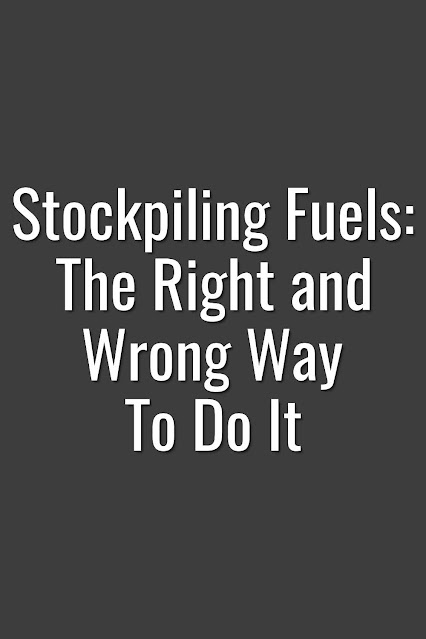Stockpiling Fuels: The Right and Wrong Way To Do It
Gas shortages are going to happen. What happened with the Colonial Pipeline was nothing new. There have been shortages since the 1970s in some way, shape, or form. In addition, natural disasters have delayed shipments for a week or longer.
However, people panic very quickly now and show very little good sense while doing so. We have seen a lot of panicking over the last fifteen months and we will continue to do so. Why?
People do not want anything to disrupt their daily lives or inconvenience them in any way. We saw it with the toilet paper shortage and we will continue to see it with anything else that may become a shortage.
Fuel, especially gas, is not necessarily something you want to stockpile large quantities unless you know what you are doing. As someone who has worked in this industry for several years, you have to be diligent and plan when stockpiling fuel.
For starters, gas is not the same as diesel. This may be common knowledge for most people, but I still run across people who think differently. Diesel has a lower octane rating than gas. Therefore, you cannot run diesel in a gas-powered vehicle or motor because gas-powered can not easily combust diesel due to the low octane in the diesel fuel.
People have tried to put diesel in their gas-powered engines and have been stranded due to that very issue. The repairs can become costly with the fuel system having to be drained and fuel filters being replaced. The engine will start running rough and start knocking until it quits running. Not a good idea.
Next, you should not stockpile gas without a good rotation plan in place. Due to the ethanol in gas, gas cannot be stockpiled for longer than 2-3 months at the most. After that, the gas will go bad unless you mix an additive into the container like Sta-Bil to preserve the gas longer. But, even then, you should still be using it up in six months.
If you plan to use gas in your vehicles, you should decide on a good rotation plan. For example, once a month, you empty the containers into your vehicles and get them refilled. You can do it every other month or half one month and half the next month. Otherwise, your gas will go bad.
There are different octane ratings in gas you should take into consideration. The higher the number (and price) on the gas, the higher the octane the gas has in it. This means it has less ethanol in it when it is higher octane. Many people use a higher octane like 91 to use in their mowers and other small engines. Higher octane gas stores better, but you still need to rotate it regularly. You can also get non-oxygenated gasoline at some pumps which have no additives like ethanol. This is best for long-term storage but still needs a regular rotation and treatment with fuel stabilizers.
Diesel will last longer than gas in storage. However, you need to know that there is a difference in diesel fuels. During the spring, summer, and fall, diesel usually is some sort of biodiesel blend. Many states have mandated this to comply with environmental regulations. This is not a problem until winter. In temperatures of 10 degrees or colder (in Fahrenheit), biodiesel will begin to “gel” in containers, barrels, and tanks, causing problems. You will have to add an anti-gelling additive before it gets too cold. If you do gel, you will have to warm up the tank somehow, add warm fuel, change plugged fuel filters, and lose valuable time doing so. Many semi-trucks come with tank heaters to combat this problem, but it’s still a problem with northern winter temperatures.
What you should stockpile is unblended diesel if you want to stockpile diesel. In the industry, we call it #1 diesel. What is sold through the rest of the year is #2 diesel. #1 diesel costs more but doesn’t gel in cold temperatures unless you get extremely cold (30-40 degrees below zero Fahrenheit). You will notice in frigid temperatures, semi-trucks are either stored inside heated buildings or not shut off at all to keep from gelling. However, #1 diesel may not be available all year round, but only in the winter.
Diesel is also different depending on the application. Diesel sold for agriculture use is dyed red and is suppose to be only used in machines that do not see road use. Tractors and some construction equipment would be good examples. You generally can not purchase this at the pump. Red diesel fuel can not be used in vehicles or semi-trucks. If you were to get caught using red diesel fuel in your vehicles, you would get fined. Red diesel fuel does not have road taxes levied on it. You can usually only get it delivered by a local fuel delivery company or a cooperative.
Whether you are storing gas or diesel, please use the correct containers for storage. If you are worried about a shortage later, purchase some containers now that are rated for gas and diesel storage.
While having gas and diesel stored is good, doing what panicked people were doing is not a good thing. So think ahead and be prepared.
Thanks for reading,
Erica

2 thoughts on “Stockpiling Fuels: The Right and Wrong Way To Do It”
not mentioned >>> gas also has different blending(s) between summer & winter for the Northern Climes …
definitely DO NOT want to carry over winter blend gas into 90+ degree summer heat >>> could have allllll kinds of trouble and even cause damage – vice versa for summer into winter ….